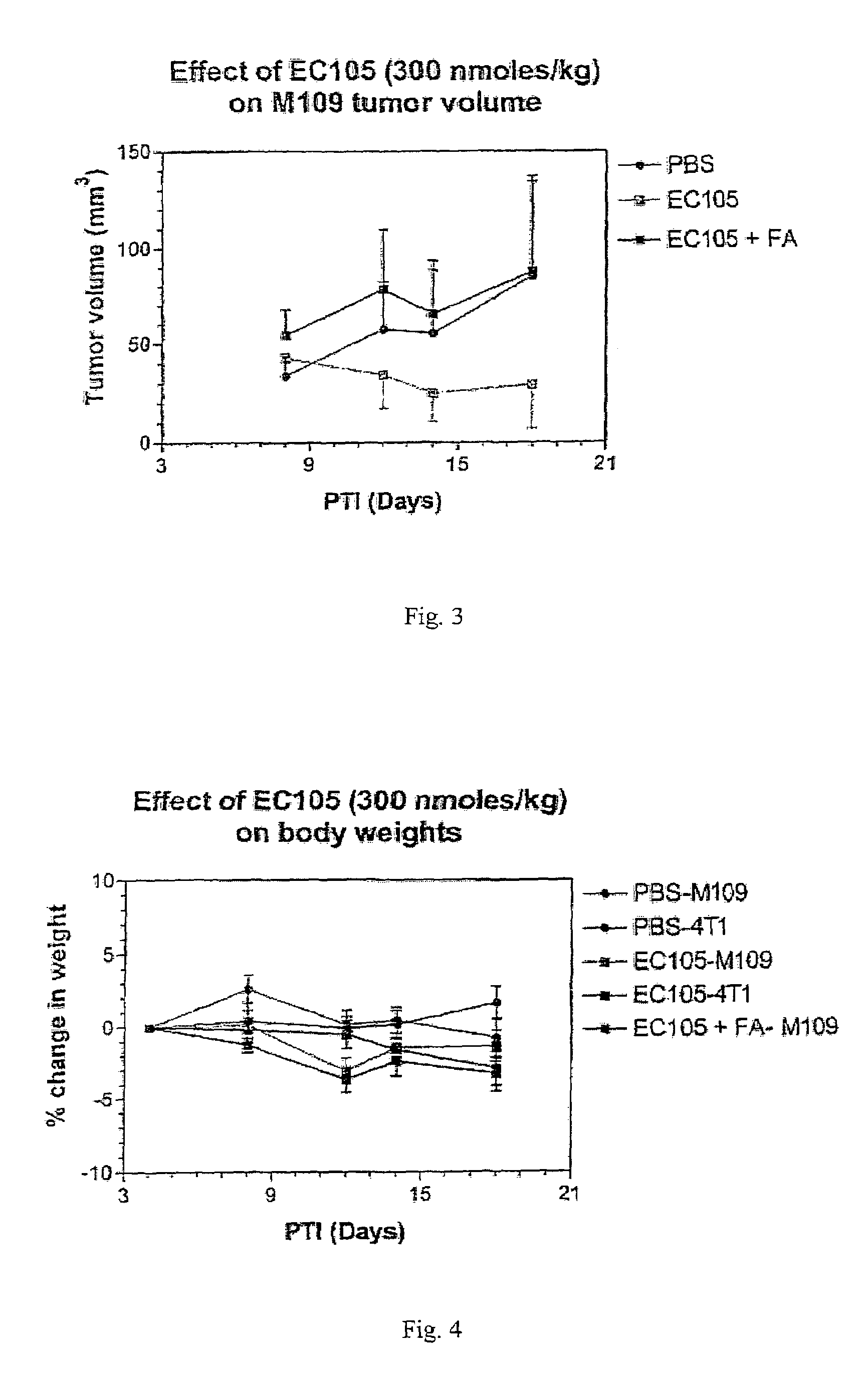Vitamin receptor binding drug delivery conjugates
a technology of vitamin receptor and conjugate, which is applied in the direction of antibacterial agents, antibody medical ingredients, and therapy, can solve the problems of complex approaches and adverse side effects of the currently available chemotherapeutic agents and radiation therapy regimens, and achieve the effect of reducing toxicity
- Summary
- Abstract
- Description
- Claims
- Application Information
AI Technical Summary
Benefits of technology
Problems solved by technology
Method used
Image
Examples
example 1
[0237]
[0238]Diethylenetriaminefolic acid, γ-amide (DETA-folate) was synthesized according to a procedure described by P. Fuchs et al., J. Am. Chem. Soc., 1997, 119, 10004, the disclosure of which is incorporated herein by reference. This compound (100 mg) was dissolved in 2 mL of 0.1 N HCl. The resulting solution was added to a solution of K2PtCl4 (158 mg) in 1 mL of 0.1 N HCl with stirring. Three mL of DMSO were added and stirring was continued for 3 days, the solution was filtered, and the filtrate precipitated in acetonitrile to give 170 mg of a yellow powder; MS (MALDI) 1249.92, 1286.27; 1H NMR (D2O) δ 1.05 (t, 1H), 2.3 (t, 2H), 3.1 (t, 2H), 4.45 (m, 1H), 6.65 (d, 2H), 7.5 (d, 2H), 8.65 (s, 1H).
example 2a
[0239]
[0240]The N10-trifluoroacetyl protected folate-containing peptidyl fragment N10-TFA-Pte-Glu-Glu-Lys-OH was prepared by a polymer-supported sequential approach using the Fmoc-strategy, as generally illustrated in Scheme 12. It was synthesized on the acid-sensitive Fmoc-Lys(Boc)-Wang resin. PyBop was applied as the activating reagent to ensure efficient coupling using low equivalents of amino acids. Fmoc protecting groups were removed after every coupling step under standard conditions (20% piperidine in DMF). Fmoc-Glu-OtBu and N10-TFA-Pte-OH were used as protected amino acid building blocks. After the last assembly step the peptide was cleaved from the polymeric support by treatment with trifluoroacetic acid, ethanedithiol and triisopropylsilane. This reaction also resulted in simultaneous removal of the t-Bu and t-Boc protecting groups. The crude peptide was purified by preparative HPLC to give N10-TFA-Pte-γGlu-γGlu-Lys-OH as a TFA salt. A solution of 81 mg (0.1 mmol) of the p...
example 2b
[0241]
[0242]The N10-trifluoroacetyl protected folate-containing peptidyl fragment N10-TFA-Pte-Glu-Cys-OH was prepared by a polymer-supported sequential approach using the Fmoc-strategy, as generally illustrated in Scheme 12, and described in Example 2a. Cystamine was reacted with mitomycin A (see Matsui et al., J. Antibiot. 21, 189-198 (1968); Vias et al., J. Org Chem. 51, 4307-4309 (1986)) giving the disulfide containing mitomycin C derivative possessing a terminal free amino group, which was coupled with levulinic acid, followed by subsequent reaction of the carbonyl group with a maleinido derivatized acyl hydrazide. Reaction of the resulting Michael acceptor with N10-TFA-Pte-Glu-Cys-OH gave the final conjugate after removal of the trifluoroacetyl protective group with aqueous ammonium hydroxide (pH=10.0), and precipitation from acetonitrile; MS (MALDI) 1059.04, 1148.44, 1225.32, 1300.8; 1H NMR (D2O) δ 1.8 (d, 2H), 1.9 (s, 1H), 2.3 (q, 1h), 2.45 (q, 1H), 2.9 (t, 1H), 3.35 (dd, 1H)...
PUM
| Property | Measurement | Unit |
|---|---|---|
| temperatures | aaaaa | aaaaa |
| temperatures | aaaaa | aaaaa |
| temperature | aaaaa | aaaaa |
Abstract
Description
Claims
Application Information
 Login to View More
Login to View More - R&D
- Intellectual Property
- Life Sciences
- Materials
- Tech Scout
- Unparalleled Data Quality
- Higher Quality Content
- 60% Fewer Hallucinations
Browse by: Latest US Patents, China's latest patents, Technical Efficacy Thesaurus, Application Domain, Technology Topic, Popular Technical Reports.
© 2025 PatSnap. All rights reserved.Legal|Privacy policy|Modern Slavery Act Transparency Statement|Sitemap|About US| Contact US: help@patsnap.com



